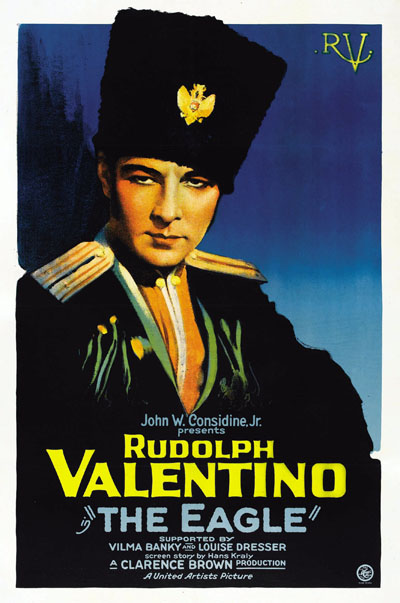Landmark Weekend, Part 2
May 5th, 2011
Last Sunday, we enjoyed the second half of our visit to the stately Landmark Loew’s Theatre of Jersey City (click here to read about the first part of our visit). It was a special performance sponsored by the Garden State Theatre Organ Society (who knew).
The first portion of the program showcased the restored Wonder-Morton Theatre Pipe Organ. This incredible instrument is a replacement for the theatre’s original organ, and has been lovingly rebuilt. I don’t know enough about theatre organs to say anything intelligent about it, and words are sadly inadequate to describe its wondrous sound. This video clip, taken during the concert, comes closest (apologies for the movement, I couldn’t stop breathing):
That’s Don Kinnier, premier theatre organist of the east coast, tickling the key stops with his nimble fingers (and toes). If you ever get a chance to see and hear Mr. Kinnier, don’t stop to think, buy the tickets! Particularly if he is accompanying a film. Though I hear he has also been known to play the conservatory organ at Longwood Gardens.
After the opening concert and a brief intermission, we got down to the feature presentation: The Eagle, considered by some critics to be Rudolph Valentino’s finest film role. It was surely one of his most varied performances, ranging from smoldering sensuality to laugh-out-loud humor. As my film-buff companion commented, it was the first time he’d seen Valentino’s teeth.
This 1925 silent film has a great storyline, based on a story by Pushkin. It also boasts lush costumes and scenery, and a tracking scene of a laden banquet table that made film history. Louise Dresser shines as the lusty czarina who falls for one of her cossacks (Valentino), forcing him to flee to the arms of the lovely and mischievous Mascha (Vilma Banky).
But let me not forget the real star of this particular screening — it was the impeccable sound track, provided by Mr. Kinnier and the Wonder-Morton. For 87 minutes, he played a solid wall of music, capturing every shadow and nuance of the film, including a dance scene where you’d swear the actors were moving to the music and not the other way around. I’ve never seen anything like it, and though my companion has seen far more silent films than I, he also assured me that this was a true tour de force.
Jealous? Well I don’t think you’ll have the chance to see Mr. Kinnier at the Loew’s anytime in the near future, but you can still catch the magic of a silent film screening with live organ music (sure to be provided by another excellent musician) on Saturday, May 21, when the Loew’s will present Murnau’s Sunrise. I’ll be there.
Instrumental Inheritance
March 26th, 2011
My better half is a song-writer of some note, and still performs regularly. Recently, he’s been hunting for a new instrument. Not to imply any lack of affection for his old guitar — a beautiful Guild with holes worn into the face from strumming (Willie’s not the only one). But he wanted something a little smaller, lighter, less imposing. It took a while, but he finally met his match with a Blueridge Parlor Guitar. What a sweet, mellow tone it has! And though the sound of the parlor guitar could fill a symphony hall, it’s nearly a third smaller than his dreadnought.
Before reaching his current bliss however, we tried out a few other instruments along the way. Instruments which I now seem to have inherited…

First, there was this autoharp. Invented in the 1880s (I think), the autoharp offers an easy way for anyone to accompany themselves without learning to finger chords. But it’s another thing to really play the autoharp well. It can be finger-picked in any style, or, with a little cleverness, can play both melody and accompaniment simultaneously.

Next, he tried a ukulele. This traditional Hawai’ian instrument was invented by a Portuguese immigrant to Hawai’i in the late 19th century. It became popular in America shortly before World War I. With only four strings, the ukulele is not terribly versatile, but it is light as a feather, and very easy to play.
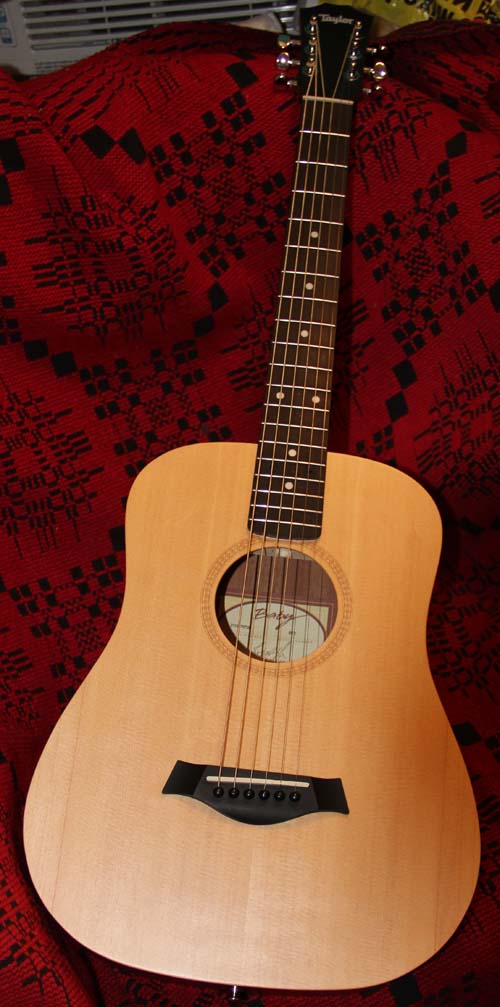
Finally, he admitted that what he really wanted was a smaller guitar. So he rushed out to the best guitar store in New York City, Carmine Street Guitars, where he saw the Blueridge parlor for the first time. But still, he hesitated. And while he was teetering on the brink, he picked up this Taylor “Baby.”
It’s an adorable little thing — steel strings, but a very light, compact body. And the fret board is quite narrow, so it fits my hand well. I’m just a bit too small to feel comfortable playing a full-sized guitar. And for someone who can barely change chords without looking, it’s a very nice instrument.
Of course, my real love remains my cello — a far better instrument than I deserve, now going on 15 years old, with a tone that gets richer every year. But, as they say, when life gives you stringed instruments, make lemonade.
Beautiful Dreamer
March 25th, 2011
“Beautiful Dreamer” was Stephen Foster’s last song, published shortly after his death in 1864. What an appropriate title for a final tune, especially at a time when sentimentalists were beginning to liken death to a deep sleep. (Yes, I know Shakespeare also made the comparison, but it fell off for a few centuries, for reasons I shall explain another time.)
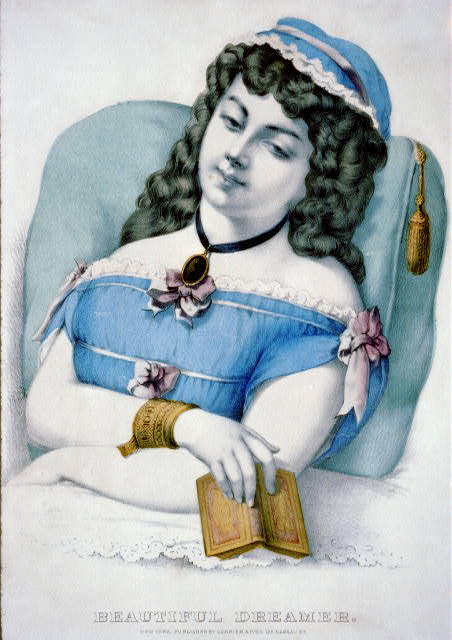
This print from Courier & Ives, while illustrating the song, also serves to illustrate the changing ideals of beauty. Compared to the stick-thin models in 21st-century fashion magazines, this Victorian beauty is decidedly zoftig. Also note her neat little “bud-like” mouth — no lip augmentation here! It is very refreshing to see such a natural looking woman idolized, but I must admit her tiny hands are a bit creepy — I guess that’s what Elizabeth Gaskell meant when she described Margaret’s “taper fingers” in North and South. Something unnatural there if you ask me.
I have been learning “Beautiful Dreamer” in anticipation of the next general meeting of the New York Nineteenth Century Society, next Monday, March 28. We decided to have a theme song, and my husband finally convinced me that “Oh! I’d Be a Sailor” wasn’t widely known enough to sing in mixed company. So far, I have learned to play the song on the auto-harp, the ukulele, and the guitar. Now if only I could carry a tune…
Dreaming Again
March 3rd, 2011
Salome
February 21st, 2011
As the Gentleman and I were walking home from dining out last Friday evening, we passed a thrift shop just north of Washington Square Park. On a whim we ducked inside, and proceeded to spend a jolly quarter of an hour poking about, turning things over, and holding up outlandish outfits for the other one to wear. In the end, the only thing we could bring ourselves to actually buy was this 78 rpm double record of Strauss’s Salome, final scene. It features soprano Ljuba Welitsch with Fritz Reiner conducing the Metropolitan Opera Orchestra.
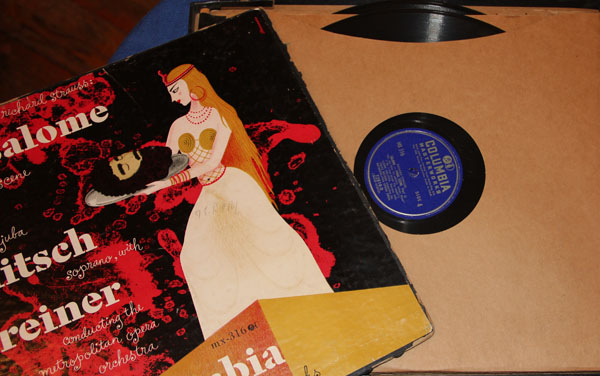
The cover is a bit beaten up, but the records themselves are as clean as if they’d hardly been played. At first I was astonished to find that a four record set contained only a single act of the opera (I have a 6 record LP set of Norma in its entirety that I invariably play during thunderstorms), but my cohort pointed out that they were 78s, and as such, each side only lasts about 4 minutes!
Although this is my first foray into Strauss’s opera, Salome has fascinated me for years. In case you haven’t already guessed, I am a great fan of Oscar Wilde. I don’t recall if I began with Dorian Gray or one of his many excellent plays, but I eventually came to his Salomé. To be quite honest, I found it a bit overdone at first (I was young), but upon learning that it had originally been written in French, I began to think better of it. And of course, there were the illustrations by Beardsley.

Beyond the literary import of Wilde’s Salomé, it also earned a place in the history of censorship and obscenity laws. Maud Allan, the dancer who dared to introduce a routine based on portions of Salomé to the British stage in the early 1900s, undertook an extensive legal battle to defend her good name from the “libelous” (and treasonous) charges leveled at her scantily clad dance of the seven veils by an ambitious MP in cahoots with the father of Wilde’s erstwhile “Boise”. For the full story on this, and how it dredged up a number of other scandalous issues in post-Victorian society, I heartily recommend Oscar Wilde’s Last Stand.You may also enjoy Alla Nazimova’s silent film version.
Any play that can provoke that much furor is deserving of its place in history!
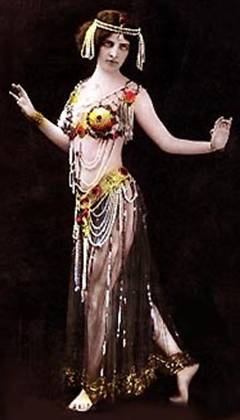
You must admit, Maud Allan chose a rather shocking costume for 1908.

